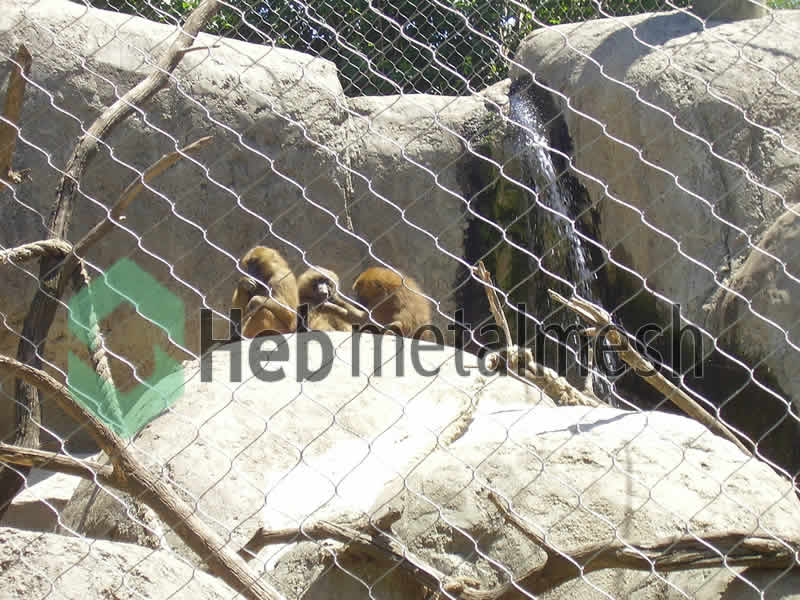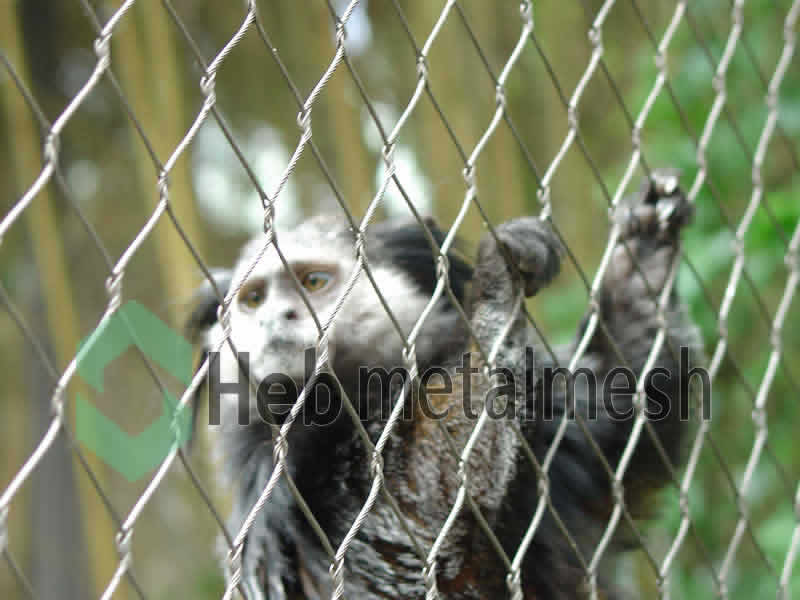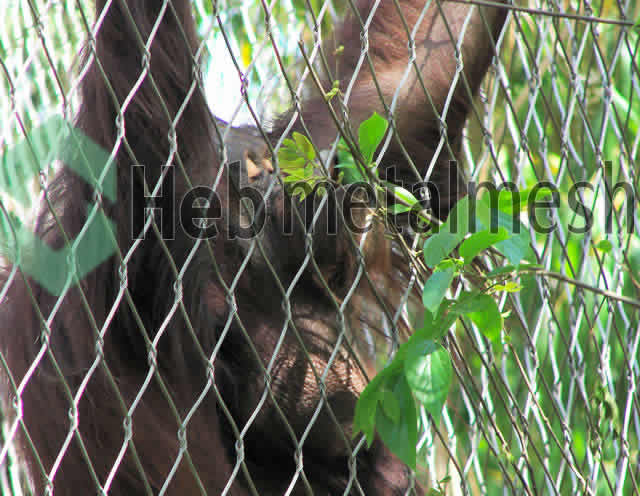Introduction to Fence Mesh for Monkeys
When designing enclosures for monkeys, the selection of suitable fence mesh is paramount. The right materials not only ensure the safety of these primates but also create an environment conducive to their natural behaviors. Monkeys are highly intelligent and curious animals, and their enclosures must be designed to meet their physical and psychological needs. This is where the importance of durable and secure fence mesh comes into play.
Durability is a key factor in choosing fence mesh for monkey enclosures. Given their natural tendencies to climb and explore, the materials used must withstand various forms of wear and tear. A high-quality fence mesh needs to resist chewing or pulling apart, ensuring that monkeys cannot escape or get injured. The resistance to environmental factors such as rust or corrosion is essential, particularly in outdoor settings where weather conditions can vary significantly.
Moreover, safety is a crucial consideration. The right fence mesh not only protects the monkeys from potential hazards but also prevents unauthorized access to their habitat. This safeguard is vital not just for the monkeys but also for the visitors and staff at the facility. When choosing mesh, it is important to consider the spacing and size of the openings, as a mesh that is too wide may pose a risk of entrapment or injury.
Additionally, the selection of appropriate fence mesh contributes to creating an enriching environment for monkeys. By incorporating materials that allow for visibility and ventilation, enclosures can mimic a more natural habitat, lessening stress and promoting well-being among the inhabitants. In summary, selecting the right fence mesh for monkey enclosures is critical in providing safe, secure, and stimulating environments that cater to the needs of these intelligent animals.
Benefits of Stainless Steel Fence Mesh
When it comes to creating a secure and long-lasting environment for monkeys, the choice of fencing material is paramount. One of the most recommended options is stainless steel fence mesh, owing to its numerous advantages over other materials. Notably, stainless steel exhibits exceptional corrosion resistance, making it particularly suitable for outdoor enclosures that are exposed to varying weather conditions. Unlike iron or untreated steel, which can rust over time, stainless steel maintains its integrity, ensuring that the fence remains intact and visually appealing throughout its lifespan.
Moreover, the structural strength of stainless steel is a vital consideration in fencing applications. The tensile strength of stainless steel fence mesh is significantly higher than that of alternatives such as vinyl or wood. This means that enclosures made from stainless steel can withstand the physical interactions of monkeys, who are known for their agility and strength. Options such as 304 and 316 grade stainless steel enhance this characteristic, with grade 316 offering added resistance to harsh environments, including those near saltwater.
Long-term durability is another noteworthy advantage of using stainless steel fence mesh for monkey enclosures. These materials are designed to withstand the rigors of time, ensuring that initial investments yield benefits over extended periods. Additionally, stainless steel requires low maintenance compared to other materials, as the non-porous surface does not harbor dirt or contaminants easily. This feature significantly reduces the labor and costs associated with upkeep. Overall, stainless steel fence mesh emerges as a reliable and efficient choice for creating monkey enclosures, offering corrosion resistance, strength, and durability, confirming its status as a sound investment for long-term use.
Understanding Grades: 304 vs 316 Stainless Steel
When selecting the appropriate fence mesh for monkey enclosures, the choice of stainless steel grade plays a crucial role in ensuring durability and safety. The two most common grades in use are 304 and 316 stainless steel. Each of these grades possesses unique properties that cater to different environmental conditions and applications.
304 stainless steel, often referred to as the standard grade, contains an alloy of 18% chromium and 8% nickel. This composition provides satisfactory corrosion resistance in many environments, making it a popular choice for a variety of fence mesh applications, including monkey enclosures. Its strength and formability allow for versatile designs that can create secure habitats. However, it’s essential to note that 304 stainless steel may not withstand exposure to harsh environments, such as those with high salt concentrations, which could lead to eventual degradation.
On the other hand, 316 stainless steel is distinguished by the addition of molybdenum, which enhances its corrosion-resistant properties significantly. This grade contains approximately 16% chromium, 10% nickel, and 2% molybdenum, making it less susceptible to pitting and crevice corrosion. As a result, 316 stainless steel is recommended for aquatic environments or coastal areas where salt exposure is prevalent. In the context of monkey habitats, utilizing 316 stainless steel fence mesh provides an added layer of protection against environmental elements, ensuring a longer lifespan and safeguarding the welfare of the monkeys.
In conclusion, the choice between 304 and 316 stainless steel for fence mesh for monkey enclosures depends on specific environmental conditions and longevity requirements. Assessing these factors will guide you toward the most suitable grade for creating a secure and durable habitat for your primate residents.
Features of Ideal Fence Mesh for Monkeys
When considering the appropriate fence mesh for monkey enclosures, several key features are crucial to ensure the safety and well-being of these intelligent animals. One of the foremost considerations is the size of the mesh openings. It is imperative to choose a mesh size that prevents monkeys from slipping through or getting their limbs trapped. Generally, a mesh size of no more than 2 inches is recommended for most species, as this provides adequate containment while allowing for ventilation and visibility.
The strength of the fence mesh is another vital factor. Monkeys are active and agile, often exhibiting behaviors that involve climbing or swinging. Therefore, the chosen mesh must possess high tensile strength to withstand these activities without risking deformation or breakage. Materials such as stainless steel or galvanized wire are ideal for preventing wear over time, as they resist rust and corrosion while providing robust support against escape attempts.
In addition to size and strength, the safety of the fence mesh for monkeys cannot be overstated. A well-designed enclosure should prevent injuries caused by sharp edges or protruding wires. Smooth, rounded finishes are essential to protect the monkeys from cuts or abrasions during their natural behaviors. It is also important to consider the height of the fencing. The enclosure should be sufficiently tall to prevent climbing out, ideally being at least 10 feet high for most species, along with an overhang to mitigate potential escape attempts.
By focusing on these features—appropriate mesh size, high strength ratings, and safety considerations—one can create a secure environment for monkeys that caters to their physical needs while ensuring their safety and well-being.
Custom Roll Sizes for Your Monkey Enclosure Needs
When selecting the appropriate fence mesh for monkey enclosures, understanding the customization options available for roll sizes is crucial. Particularly, the maximum roll size typically offered stands at 30′ x 60′, which provides a substantial amount of material to work with. However, enclosures vary greatly in their design and dimensions, necessitating a more tailored approach to ensure each space is adequately secured and safe for the animals.
Custom roll sizes of fence mesh for monkey enclosures can be requested to perfectly fit individual specifications. This flexibility is essential, especially for those who require irregular shapes or sizes due to their unique setups. By discussing specific enclosure measurements with your supplier, you can obtain a fence mesh roll that aligns well with your requirements. This not only enhances the aesthetic of the enclosure but also contributes to the well-being and comfort of the monkeys housed within.
Tailored roll sizes allow for better integration of the fence mesh into existing structures, whether they are new builds or modifications to current enclosures. The installation process can be significantly simplified, as properly sized rolls minimize excess material and consequent waste. Furthermore, having the correct size reduces the need for additional cuts and adjustments that would otherwise be necessary with standard sizes.
Incorporating customized fence mesh produces a more secure environment for the monkeys, preventing potential escape and ensuring that external threats cannot easily penetrate the enclosure. When making a decision on your fence mesh for monkey enclosures, prioritizing custom roll sizes could significantly impact not only the aesthetic of the space but also the safety and security of the monkeys themselves.
Installation Tips for Stainless Steel Fence Mesh
When installing stainless steel fence mesh for monkey enclosures, proper preparation is critical to ensure a secure and safe installation. Begin by assessing the enclosure site; ensure it is free from debris and any obstructions that may hinder the fence’s stability. It is also essential to plan your layout, measuring the perimeter accurately to determine the amount of fence mesh required. Prepare a checklist of necessary tools, such as a post hole digger, a level, wire cutters, and safety gloves, to facilitate a smooth installation process.
Before starting the physical installation, it is advisable to mark the positions of the fence posts. The spacing between posts should not exceed six to eight feet to ensure the fence mesh maintains its integrity. Once the locations are marked, use the post hole digger to create holes that are at least two feet deep, providing a solid foundation for the posts. Install the posts into the holes and ensure they are level, using concrete to secure them in place if necessary. Allow the concrete to cure according to the manufacturer’s instructions before proceeding.
After the posts are securely installed, carefully roll out the stainless steel fence mesh along the posts. When attaching the mesh, utilize heavy-duty fasteners or ties to secure it firmly. It is crucial to maintain tension in the fence mesh while installing it to prevent sagging or loosening over time. For added durability, consider using tension wires along the top and bottom edges of the mesh. Regularly inspect the installation for any signs of wear, particularly if the enclosure is exposed to varying weather conditions or the natural behavior of the monkeys.
Following these installation tips will ensure that your stainless steel fence mesh provides a secure environment for your monkeys, safeguarding their wellbeing and enhancing the overall integrity of the enclosure.
Maintenance of Stainless Steel Fence Mesh
Maintaining stainless steel fence mesh is essential for ensuring the longevity and safety of monkey enclosures. Regular maintenance helps to identify any potential issues early and ensures that the mesh continues to serve its purpose effectively. A systematic approach to cleaning and inspections can go a long way in preserving the integrity of the fence.
Firstly, cleaning is a vital aspect of maintenance. Stainless steel fence mesh is generally resistant to rust and corrosion, but it can accumulate dirt and organic material over time. To clean the mesh, use a soft brush or cloth along with a mild detergent solution. Avoid abrasive cleaners or tools, as they can scratch the surface. Rinsing the mesh thoroughly with water after cleaning will help ensure that no cleaning products remain, as residue can lead to deterioration. It is advisable to conduct this cleaning process at least bi-annually, or more frequently if the enclosure is situated in a particularly dirty environment.
Periodic inspections are equally important. Inspect the fence mesh for signs of wear, damage, or any loose fittings. Look for areas where the mesh may be sagging, or where connections with posts have weakened. Early detection of these issues can prevent larger problems down the line, including potential escape routes for the monkeys. It is recommended to carry out these inspections at least once a season, taking special care after severe weather events that may have impacted the integrity of the enclosure.
In conclusion, the maintenance of stainless steel fence mesh is crucial to ensuring the safety and durability of monkey enclosures. By prioritizing regular cleaning and thorough inspections, owners and caregivers can effectively extend the lifespan of the fence while ensuring a safe environment for the monkeys within. Making this commitment not only enhances the shelter but also contributes to the overall well-being of the animals housed.
Choosing the Right Supplier for Fence Mesh
When it comes to selecting fence mesh for monkey enclosures, choosing a reliable supplier is crucial for ensuring the safety and well-being of the animals. A reputable supplier should possess a strong track record and positive reputation within the industry. Start by researching potential suppliers and looking for customer reviews and testimonials that speak to their reliability and professionalism. This will help gauge their credibility and the level of quality they provide in their products, such as stainless steel fence mesh, which is often preferred for its strength and durability.
Product quality is another essential factor to consider. The fence mesh for monkey enclosures should meet specific safety standards suitable for the monkeys’ needs. Therefore, check if the supplier provides product specifications, including the gauge of the wire, mesh size, and corrosion resistance. A reputable supplier will be transparent about these details, ensuring that you are making an informed decision. When evaluating materials, stainless steel is often highlighted for its robust characteristics, making it a favored choice for creating secure enclosures.
Additionally, customer service plays a significant role in the selection process. A good supplier should be willing to address any concerns or questions regarding their fence mesh products. This includes providing guidance on installation, maintenance, and any other inquiries that may arise. Superior customer service can make a significant difference in your overall experience, especially if you are new to setting up monkey enclosures.
In conclusion, when choosing the right supplier for fence mesh, focus on their reputation, product quality, and customer service. By taking these factors into account, you will be well-equipped to select a reliable supplier who meets your needs and ensures the safety of your monkey enclosure.
Conclusion: The Right Fence Mesh for Happy Monkeys
Choosing the right fence mesh for monkey enclosures is crucial for ensuring the safety and well-being of these intelligent animals. A suitable fence mesh not only protects the monkeys from potential external threats but also provides them with a secure environment conducive to their natural behaviors. The characteristics of fence mesh, including its durability, gauge, and design, play a significant role in preventing escapes and safeguarding against interactions with humans or other animals.
Throughout this guide, we explored various factors that influence the selection of effective fence mesh. High-quality materials resistant to wear and vandalism are essential for maintaining the integrity of the enclosure. Additionally, the spacing of the mesh openings must be carefully considered; this ensures that monkeys cannot squeeze through or become entangled, which poses risks to their health and safety. Using appropriate materials such as stainless steel or heavy-duty vinyl can further enhance the longevity of the fencing.
The importance of aesthetics and the specific needs of the monkey species in your care cannot be overlooked. By understanding the behavior and physical capabilities of different monkey species, caregivers can tailor their fencing decisions accordingly. This custom approach leads to an enclosure that meets the monkeys’ needs for climbing, exploring, and socializing, contributing to their happiness and well-being.
In conclusion, selecting the right fence mesh for monkey enclosures involves careful consideration of multiple elements. Prioritizing safety, durability, and the unique behavioral characteristics of monkeys will ultimately lead to a healthier and happier environment for these captivating creatures. As you make your fencing decisions, consider the information provided to ensure that the monkeys in your care flourish in a secure and enriching habitat.
✅Goto monkey enclosure mesh product page to understand more…


